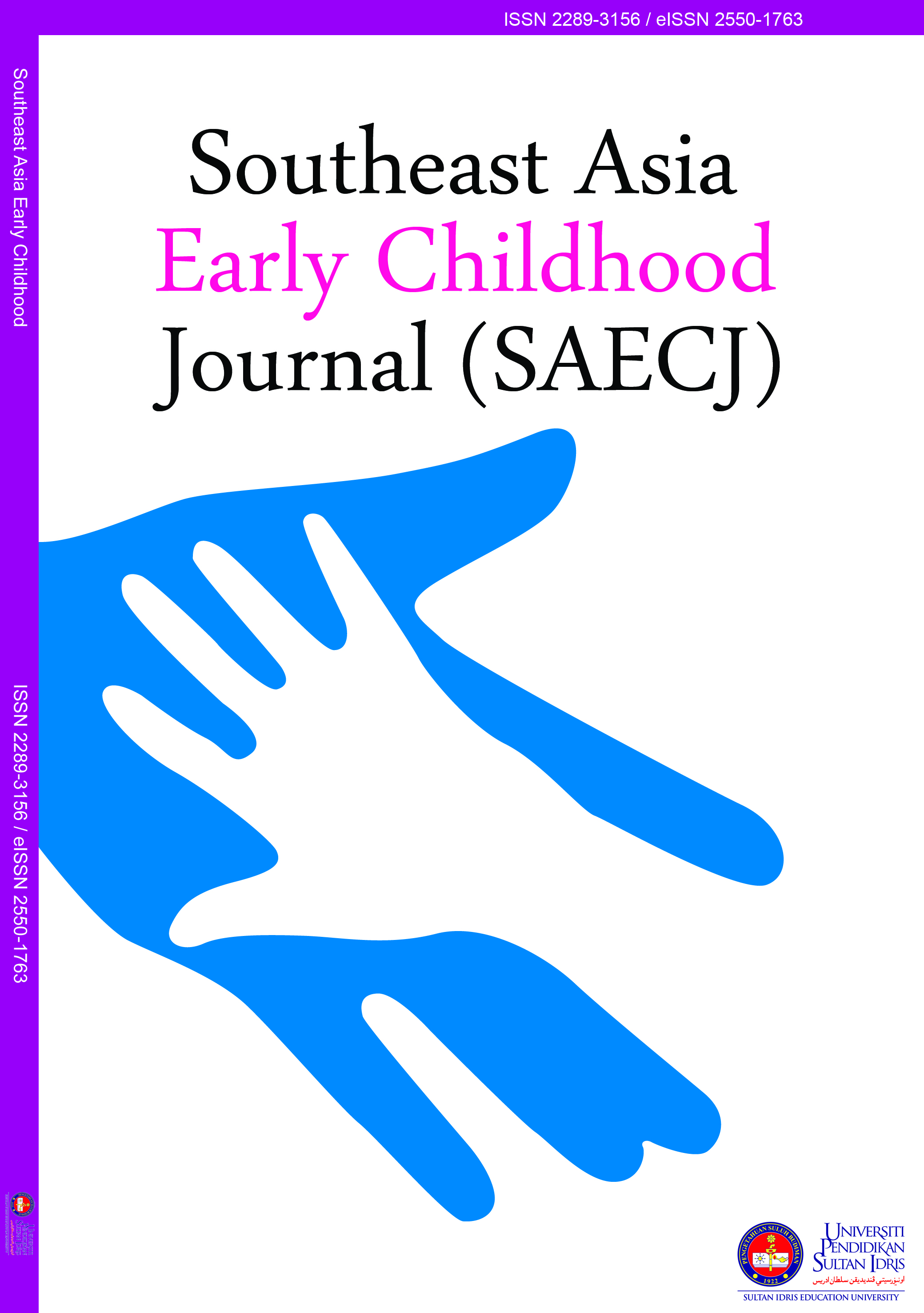Aplikasi kaedah fuzzy delphi dalam pembangunan kerangka penilaian kecergasan fizikal berasaskan kesihatan kanak-kanak prasekolah
Application of fuzzy delphi methods in the development of health-related physical fitness assessment framework in Malaysian preschool children
DOI:
https://doi.org/10.37134/saecj.vol10.sp.7.2021Keywords:
kaedah fuzzy delphi, kerangka, penilaian kecergasan fizikal, prasekolah, fuzzy delphi method, framework, physical fitness assessment, preschoolAbstract
Kajian ini bertujuan mendapatkan kesepakatan pakar tentang komponen dan ujian bagi reka bentuk dan pembangunan kerangka penilaian kecergasan fizikal berasaskan kesihatan kanak-kanak prasekolah Malaysia. Pembangunan kerangka penilaian ini menggunakan kaedah Fuzzy Delphi. Borang soal selidik diedarkan kepada sejumlah 17 orang sampel yang terlibat sebagai pakar bidang dalam proses reka bentuk dan pembangunan. Borang soal selidik komponen kecergasan mengandungi enam bahagian, iaitu: (1) maklumat demografi; (2) komponen komposisi badan; (3) komponen daya tahan kardiovaskular; (4) komponen daya tahan otot tangan; (5) komponen kekuatan otot kaki; dan (6) komponen fleksibiliti. Manakala, soal selidik ujian kecergasan pula mempunyai lapan bahagian, iaitu; (1) maklumat demografi; (2) indeks jisim badan; (3) ukuran peratus lemak badan; (4) larian ulang alik 20 meter; (5) larian 1200 meter; (6) genggaman tangan; (7) lompat jauh berdiri; dan (8) jangkauan melunjur. Analisis kaedah Fuzzy Delphi menunjukkan komponen komposisi badan, daya tahan kardiovaskular, daya tahan otot tangan, kekuatan otot kaki, dan fleksibiliti diterima sebagai komponen kerangka penilaian. Ujian-ujian yang diterima bagi setiap komponen ialah indeks jisim badan, larian ulang-alik, genggaman tangan, larian lompat berdiri, dan jangkauan melunjur. Hal ini disebabkan oleh komponen dan ujian telah memenuhi syarat triangular fuzzy number iaitu nilai threshold (d) ≤ 0.2 dan peratus kesepakatan pakar ≥ 75%. Kajian ini telah menghasilkan komponen dan ujian dalam kerangka penilaian kecergasan fizikal berasaskan kesihatan kanak-kanak prasekolah Malaysia yang diharapkan dapat digunakan oleh pelbagai pihak berkepentingan terutamanya Kementerian Pendidikan Malaysia (KPM) dalam meningkatkan kecergasan fizikal kanak-kanak prasekolah.
This study aims to obtain expert agreement on the components and tests for the design and development of health-related physical fitness assessment framework in Malaysian preschool children. The development of this evaluation framework uses a Fuzzy Delphi method. Questionnaires were distributed to a total of 17 samples who were involved as field experts in the design and development process. The fitness component questionnaire consists of six section, namely; (1) demographic information; (2) body composition components; (3) cardiovascular endurance components; (4) hand muscle endurance components; (5) leg muscle strength components; and (6) flexibility components. Meanwhile, the fitness test questionnaire also has eight sections, namely; (1) demographic information; (2) body mass index; (3) body fat percentage measurement; (4) 20 meter shuttle run; (5) 1200 meter run; (6) hand grip; (7) standing long jump; and (8) sit-and-reach test. Data was analysed using the Fuzzy Delphi analysis template, showed that body composition components, cardiovascular endurance components, hand muscle endurance components, leg muscle strength components, and flexibility components were accepted as components of the assessment framework. Body mass index, shuttle run, hand grip, standing long jump, and sit-and-reach tests were accepted for each component, respectively. This is because the components and tests have met the requirements of the triangular fuzzy number, namely, the threshold value (d) ≤ 0.2 and the percentage of expert agreement ≥ 75%. This study has produced a health-related physical fitness assessment framework in Malaysian preschool children that can be used by various stakeholders, especially the Ministry of Education Malaysia (MOE) in improving the physical fitness of preschool children.
Downloads
References
Adler, M., & Ziglio, E. (1996). Gazing into oracle: Delphi method and its application to social policy and public health. Jessica Kingsley Publisher.
Bahagian Pembangunan Kurikulum. (2016). Dokumen Standard Kurikulum dan Pentaksiran. Kemnterian Pendidikan Malaysia.
Basir, J. M., Zain, A., & Osman, Z. (2020). Kesahan dan kebolehpercayaan Soal Selidik Kekangan Melaksanakan Aktiviti Fizikal di Prasekolah. International Journal of Modern Education, 2(4), 90-101.
Cheng, C., & Lin, Y. (2002). Evaluating the best main battle tank using fuzzy decision theory with linguistic criteria evaluation. European Journal of Operational Research, 142, 174-186. https://doi.org/10.1016/j.jsurg.2017.06.018
Chu, H. C., & Hwang, G. J. (2008). A Delphi-based approach to developing expert systems with the cooperation of multiple experts. Expert Systems with Applications, 34(8), 26-40.
Erwan Ismail, & Mohd Radzani. (2017). Tahap kecergasan fizikal berlandaskan kesihatan dan corak aktiviti fizikal murid sekolah di gugusan FELDA. Prosiding Seminar Serantau Ke VIII (Pp. 1052-1056). Bangi : UKM.
Jones, H., & Twiss, B. L. (1978). Forecasting technology for planning decisions. Mac Millan
Kolimechkov, S. (2017). Physical fitness assesment in children and adolescents: A systematic review. European Journal of Physical Education and Sport Scinces, 65-79.
Mohd Ridhuan, M. J., Saedah, S., Zaharah, H., Nurulrabihah, M. N., & Arifin S., (2014). Pengenalan asas kaedah Fuzzy Delphi dalam penyelidikan rekabentuk pembangunan. Minda Intelek Agency.
Murray, J., & Hammons, J. (1995). Delphi: A versatile methodology for conducting qualitative research. Review of Higher Education, 18(4), 23-36.
Murray, T., Pipino, L., & Vangigch, J. (1985). A pilot study of fuzzy set modification of Delphi. Human System Management, 5(1), 6-80.
Ortega, F. B., Cadenas-Sanchez, C., Sanchez-Delgado, G., Maro-Gonzalez, J., Tellez, B. M., Artero, E. G., & Ruiz, J. R. (2014). Systematic review and proposal of a field-based physical education fitness- test battery in preschool children: The PREFIT Battery. Sports Med.
Wee, B. S., Poh, B. K., Bulgiba, A., Ismail, M. N., Ruzita, A. T., & Hills, A. P. (2013). Risk of metabolic syndrome among children living in metropolitan Kuala Lumpur: A case control study. BMC Public Health 11(1): 333-339
Wojcicki, M. (2012). The effects of physical activity education on exercise self- efficacy and physical activity: A comparison study between exercise science and physical education teacher education. Ph.D. Thesis, University of Arkansas, Fayetteville, USA.
World Health Organization. (2010). Global recommendations on physical activity for health.
Downloads
Published
Issue
Section
License
Copyright (c) 2021 Jamilah Mohd Basir, Azizah Zain, Siti Hartini Azmi

This work is licensed under a Creative Commons Attribution-NonCommercial-ShareAlike 4.0 International License.





